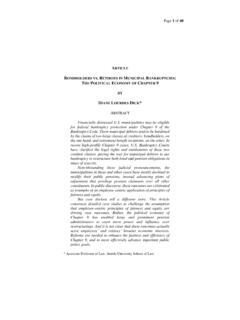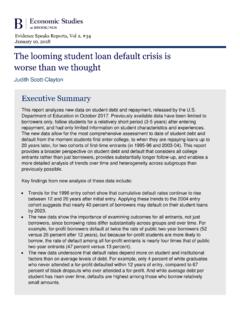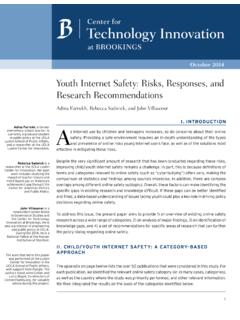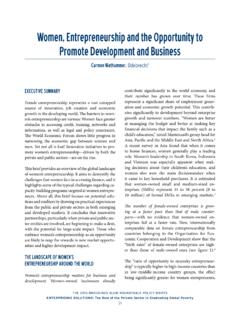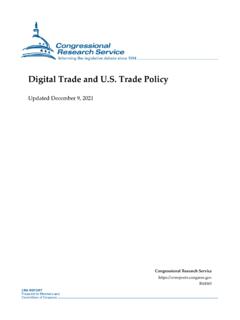Transcription of Removing regulatory barriers to telehealth before and ...
1 1 Removing regulatory barriers to telehealth before and after COVID-19 Nicol Turner Lee, Jack Karsten, and Jordan Roberts INTRODUCTIONA combination of escalating costs, an aging population, and rising chronic health-care conditions that account for 75% of the nation s health-care costs paint a bleak picture of the current state of American health In 2018, national health expenditures grew to $ trillion and accounted for of Under current laws, national health spending is projected to grow at a rate of per year between Time, another cornerstone of cost and quality, is yet another category where American health care falls short; it typically takes two hours to see a doctor for 20 minutes in most While the Affordable Care Act (ACA) sought to close the uninsured gap, immediate and affordable access to health care was not always available, especially for certain populations.
2 Among people of color, health disparities have been extensively documented, largely due to pre-existing medical or chronic conditions, including those affecting the more aged in this Rural communities are also impacted by the lack of proximity to local medical facilities and In March 2020, the entire health-care system from hospitals to medical practitioners to first responders was further challenged by the rapid and mass spread of the novel coronavirus and its associated disease, COVID-19. Medical institutions and providers were impacted by the lack of personal protective equipment (PPE), insufficient patient testing, and institutional stresses in the care of infected persons.
3 Beyond the , negative health outcomes of COVID-19 have debilitated entire countries from China to Italy and more, bringing devastating mortality rates. While the search for a global vaccination to cure the disease is in process, the stress on medical providers and hospitals prompted a historic move toward the authorization and adoption of tele-health services. Embroiled in decades-old debates over its effectiveness in providing patient care, telehealth has also faced other obstacles to its adoption and use, including licensure, reimburse-ment, and eligible services.
4 Yet, in response to the coronavirus outbreak, the Trump administration Nicol Turner Lee is a Fellow in the Governance Studies program at The Brookings Institution, housed within the program s Center for Technology Karsten is a Senior Research Analyst in the Governance Studies program at The Brookings Institution, housed within the program s Center for Technology Roberts is a Health Care Policy Analyst at The John Locke 2020 Removing barriers to telehealth before and after COVID-19 2and the Department of Health and Human Services (HHS)
5 Sweepingly approved the use of telehealth services as part of the Coronavirus Preparedness and Response Supplemental Appropriations As part of this newly granted permission, most Medicare payment requirements were waived and recipients were able to access remote care, regardless of where they live. During the pandemic, telehealth services were also charged at the same rate of in-person medical services, or at parity. The move to accelerate the use of telehealth services also included other exemptions, including some HIPAA exceptions for providers when Facetime or Skype was used by doctors to communicate with COVID-19, telehealth initiatives provided a platform to combat the shortcomings of cost, quality, and access ingrained in American health care.
6 The breadth of telehealth services includes remote clinical health care, patient and professional health-related education, public health, and health administration via electronic information and telecommunication Health-care delivery services are also integrating artificial intelligence (AI) systems into the suite of telehealth services, as both doctors and patients move from solely remote patient monitoring for continuous recording of vital signs to real-time alerts from a patient sensor when there is a deteriorating change in condition.
7 Further, AI is assisting in the management of chronic conditions, including diabetes and heart disease, and when patients require care from multiple specialists working at different times and locations. In these instances, existing applications, AI, and other emerging technologies are coordinated under the guise of telemedicine for complex treatments, like virtual assistants to help patients carry out treatment plans by sending reminders to take medications and providing relevant health to the coronavirus outbreak, telehealth and inte-grated AI were somewhat familiar though not common in practice.
8 But the increasing use of technology has not necessarily been embraced by the long-standing rules and regulations governing the full body of the health-care system. Until recently, telehealth use has largely been limited, stifled by the ambiguous and often changing regula-tions on the reimbursement of doctors and licensure, especially across state lines. State and federal barriers in the use of telehealth and AI have served as hindrances to the launch of its full capabilities, particularly those laws that present a patchwork of accepted and non-eligible costs and services.
9 Given that telehealth now has a critical role in the mitigation of COVID-19, how well will the take guidance from its rapid adoption and use? More specifically, how can telehealth be more visibly positioned as an important aspect of health-care delivery in a post COVID-19 health-care ecosystem? And, will telehealth practices be continued without the previously applied restrictions of state and federal laws, especially those around service reimbursement or parity agreements?This paper explores these questions to extrapolate what state and federal policies will need to be adopted to poten-tially prepare for more ubiquitous adoption and use of telehealth services in an expanded set of use cases than those recorded by law.
10 The authors also explore the application of existing and emerging state parity laws, which could serve as an obstacle to telehealth delivery in the future. Despite their application as a framework for reimbursement during the current application, the paper will provide guidance on these and other state and federal laws that will run counter to the long-term promotion and patient access of digital technologies, particularly those that aid in the management of primary care, chronic health conditions, and prevention. The paper concludes with a set of policy and pragmatic proposals that combine the recent lessons learned by the health-care community and patients, along with larger issues, including broadband access, that set the stage for future use.
